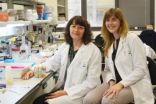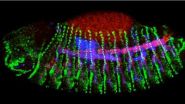(Press-News.org) Cell migration is highly coordinated and occurs in processes such as embryonic development, wound healing, the formation of new blood vessels, and tumour cell invasion. For the successful control of cell movement, this process has to be determined and maintained with great precision. In this study, the scientists used tracheal cells of the fruit fly Drosophila melanogaster to unravel the signalling mechanism involved in the regulation of cell movements.
The research describes a new molecular component that controls the expression of a molecule named Fibroblast Growth Factor (FGF) in Drosophila embryos. The importance of FGF in cell migration was already known but little information was available on its genetic regulation. In the study, Araújo and her team have discovered that a protein called Hedgehog, known to be involved in morphogenesis, regulates FGF expression.
"This is the first time that a direct connection has been demonstrated between the Hedgehog pathway and an increase in FGF during cell migration," says Araújo.
"The results are really interesting for biomedicine," explains the researcher, "as the Hedgehog pathway is overexpressed in some of the most invasive tumours, such as the most common kind of skin cancer."
The team explains that this is a step forward for research into cell migration mechanisms and that future applications will emerge as further investigation and studies are conducted.
INFORMATION:
Reference article:
Hedgehog is a positive regulator of FGF signalling during embryonic cell migration
Elisenda Butí, Duarte Mesquita and Sofia J. Araújo
Plos One (2014) 10.1371/journal.pone.0092682
A study using Drosophila flies reveals new regulatory mechanisms of cell migration
The study by Sofia J. Araújo sheds light on the fields of development, wound healing, angiogenesis, and tumour invasion, processes in which cell migration is crucial
2014-03-21
ELSE PRESS RELEASES FROM THIS DATE:
Switching an antibiotic on and off with light
2014-03-21
This news release is available in German. Scientists of the KIT and the University of Kiev have produced an antibiotic, whose biological activity can be controlled with light. Thanks to the robust diarylethene photoswitch, the antimicrobial effect of the peptide mimetic can be applied in a spatially and temporally specific manner. This might open up new options for the treatment of local infections, as side effects are reduced. The researchers present their photoactivable antibiotic with the new photomodule in a "Very Important Paper" of the journal "Angewandte Chemie". ...
cfaed presents the new microchip 'Tomahawk 2' at the DATE'14 in Dresden
2014-03-21
The Center for Advancing Electronics Dresden (cfaed) presents its new microchip 'Tomahawk 2' at the DATE'14 Conference in the International Congress Center Dresden from March 24 to 28, 2014. The new Tomahawk is extremely fast, energy-efficient and resilient. It is a heterogeneous multi-processor which can easily integrate very different kinds of devices. The researchers of the Cluster of Excellence for microelectronics of Technische Universität Dresden use the new prototype to prepare the so-called 'tactile internet'. With this, very big data volumes shall be transmitted ...
New study shows we work harder when we are happy
2014-03-21
Happiness makes people more productive at work, according to the latest research from the University of Warwick.
Economists carried out a number of experiments to test the idea that happy employees work harder. In the laboratory, they found happiness made people around 12% more productive.
Professor Andrew Oswald, Dr Eugenio Proto and Dr Daniel Sgroi from the Department of Economics at the University of Warwick led the research.
This is the first causal evidence using randomized trials and piece-rate working. The study, to be published in the Journal of Labor Economics, ...
Surprising new way to kill cancer cells
2014-03-21
Northwestern Medicine scientists have demonstrated that cancer cells – and not normal cells – can be killed by eliminating either the FAS receptor, also known as CD95, or its binding component, CD95 ligand.
"The discovery seems counterintuitive because CD95 has previously been defined as a tumor suppressor," said lead investigator Marcus Peter, professor in medicine-hematology/Oncology at Northwestern University Feinberg School of Medicine. "But when we removed it from cancer cells, rather than proliferate, they died."
The findings were published March 20 in Cell Reports. ...
Stem cell study finds source of earliest blood cells during development
2014-03-21
Irvine, Calif., March 20, 2014 — Hematopoietic stem cells are now routinely used to treat patients with cancers and other disorders of the blood and immune systems, but researchers knew little about the progenitor cells that give rise to them during embryonic development.
In a study published April 8 in Stem Cell Reports, Matthew Inlay of the Sue & Bill Gross Stem Cell Research Center and Stanford University colleagues created novel cell assays that identified the earliest arising HSC precursors based on their ability to generate all major blood cell types (red blood ...
New infrared technique aims to remotely detect dangerous materials
2014-03-21
For most people, infrared technology calls to mind soldiers with night-vision goggles or energy audits that identify where heat escapes from homes during the winter season.
But for two Brigham Young University professors, infrared holds the potential to spot from afar whether a site is being used to make nuclear weapons.
Statistics professor Candace Berrett developed a model that precisely characterizes the material in each pixel of an image taken from a long-wave infrared camera. The U.S. National Nuclear Security Administration funded the project through a grant ...
The gene family linked to brain evolution is implicated in severity of autism symptoms
2014-03-21
The same gene family that may have helped the human brain become larger and more complex than in any other animal also is linked to the severity of autism, according to new research from the University of Colorado Anschutz Medical Campus.
The gene family is made up of over 270 copies of a segment of DNA called DUF1220. DUF1220 codes for a protein domain – a specific functionally important segment within a protein. The more copies of a specific DUF1220 subtype a person with autism has, the more severe the symptoms, according to a paper published in the PLoS Genetics. ...
Stanford professor maps by-catch as unintended consequence of global fisheries
2014-03-21
Seabirds, sea turtles and marine mammals such as dolphins may not appear to have much in common, other than an affinity for open water. The sad truth is that they are all unintended victims – by-catch – of intensive global fishing. In fact, accidental entanglement in fishing gear is the single biggest threat to some species in these groups.
A new analysis co-authored by Stanford biology Professor Larry Crowder provides an unprecedented global map of this by-catch, starkly illustrating the scope of the problem and the need to expand existing conservation efforts in certain ...
Homeless with TBI more likely to visit ER
2014-03-21
TORONTO, March 21, 2014—Homeless and vulnerably housed people who have suffered a traumatic brain injury at some point in their life are more likely to visit an Emergency Department, be arrested or incarcerated, or be victims of physical assault, new research has found.
"Given the high costs of Emergency Department visits and the burden of crime on society, these findings have important public health and criminal justice implications," the researchers from St. Michael's Hospital wrote today in the Journal of Head Trauma Rehabilitation.
Traumatic brain injuries, such as ...
Dust in the wind drove iron fertilization during ice age
2014-03-21
Researchers from Princeton University and the Swiss Federal Institute of Technology in Zurich have confirmed that during the last ice age iron fertilization caused plankton to thrive in a region of the Southern Ocean.
The study published in Science confirms a longstanding hypothesis that wind-borne dust carried iron to the region of the globe north of Antarctica, driving plankton growth and eventually leading to the removal of carbon dioxide from the atmosphere.
Plankton remove the greenhouse gas carbon dioxide (CO2) from the atmosphere during growth and transfer it ...
LAST 30 PRESS RELEASES:
NTP-enhanced lattice oxygen activation in Ce-Co catalysts for low-temperature soot combustion
Synergistic interface engineering in Cu-Zn-Ce catalysts for efficient CO2 hydrogenation to methanol
COVID-19 leaves a lasting mark on the human brain
Scientists use ultrasound to soften and treat cancer tumors without damaging healthy tissue
Community swimming program for Black youth boosts skills, sense of belonging, study finds
Specific depressive symptoms in midlife linked to increased dementia risk
An ‘illuminating’ design sheds light on cholesterol
Who is more likely to get long COVID?
Study showcases resilience and rapid growth of “living rocks”
Naval Research Lab diver earns Office of Naval Research 2025 Sailor of the Year
New Mayo-led study establishes practical definition for rapidly progressive dementia
Fossil fuel industry’s “climate false solutions” reinforce its power and aggravate environmental injustice
Researchers reveal bias in a widely used measure of algorithm performance
Alcohol causes cancer. A study from IOCB Prague confirms damage to DNA and shows how cells defend against it
Hidden viruses in wastewater treatment may shape public health risks, study finds
Unlock the power of nature: how biomass can transform climate mitigation
Biochar reshapes hidden soil microbes that capture carbon dioxide in farmland
Reducing saturated fat intake shows mortality benefit, but only in high-risk individuals
Manta rays create mobile ecosystems, study finds
Study: Mixed results in using lipoic acid to treat progressive multiple sclerosis
Norbert Holtkamp appointed director of Fermi National Accelerator Laboratory
New agentic AI platform accelerates advanced optics design
Biologists discover neurons use physical signals — not electricity — to stabilize communication
Researchers discover that a hormone can access the brain by hitchhiking
University of Oklahoma researcher awarded funding to pursue AI-powered material design
Exploring how the visual system recovers following injury
Support for parents with infants at pediatric check-ups leads to better reading and math skills in elementary school
Kids’ behavioral health is a growing share of family health costs
Day & night: Cancer disrupts the brain’s natural rhythm
COVID-19 vaccination significantly reduces risk to pregnant women and baby
[Press-News.org] A study using Drosophila flies reveals new regulatory mechanisms of cell migrationThe study by Sofia J. Araújo sheds light on the fields of development, wound healing, angiogenesis, and tumour invasion, processes in which cell migration is crucial





